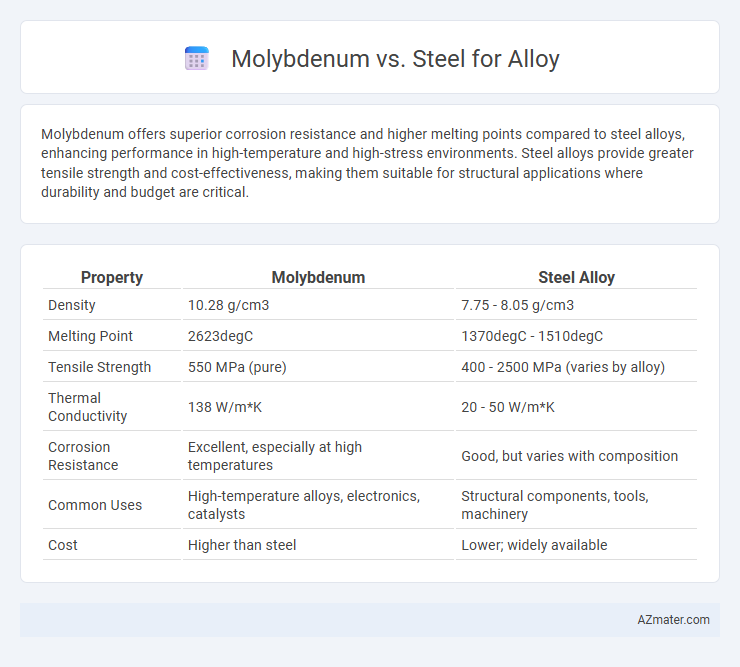Molybdenum offers superior corrosion resistance and higher melting points compared to steel alloys, enhancing performance in high-temperature and high-stress environments. Steel alloys provide greater tensile strength and cost-effectiveness, making them suitable for structural applications where durability and budget are critical.
Table of Comparison
| Property | Molybdenum | Steel Alloy |
|---|---|---|
| Density | 10.28 g/cm3 | 7.75 - 8.05 g/cm3 |
| Melting Point | 2623degC | 1370degC - 1510degC |
| Tensile Strength | 550 MPa (pure) | 400 - 2500 MPa (varies by alloy) |
| Thermal Conductivity | 138 W/m*K | 20 - 50 W/m*K |
| Corrosion Resistance | Excellent, especially at high temperatures | Good, but varies with composition |
| Common Uses | High-temperature alloys, electronics, catalysts | Structural components, tools, machinery |
| Cost | Higher than steel | Lower; widely available |
Introduction to Molybdenum and Steel Alloys
Molybdenum alloys are valued for their high strength, corrosion resistance, and ability to withstand extreme temperatures, making them essential in aerospace and industrial applications. Steel alloys, composed primarily of iron and carbon, offer versatile mechanical properties and cost-effectiveness, widely used in construction, automotive, and manufacturing sectors. Comparing molybdenum and steel alloys highlights molybdenum's superior performance in specialized environments versus steel's broader utility and economic advantage.
Chemical Composition: Molybdenum vs Steel
Molybdenum, a refractory metal, typically contains about 99.95% molybdenum with minimal impurities, offering excellent corrosion resistance and high-temperature strength, whereas steel primarily consists of iron (around 98%) combined with carbon content ranging from 0.02% to 2.14%, alongside elements like manganese, chromium, and nickel that influence its mechanical properties. The chemical composition of molybdenum alloys often includes small percentages of titanium and zirconium to enhance hardness and corrosion resistance, while steel variants vary widely in alloying elements, such as chromium in stainless steel to improve oxidation resistance or vanadium to increase toughness. The fundamental difference lies in molybdenum's high melting point (2623degC) and low thermal expansion, making it ideal for high-stress, high-temperature environments, compared to steel's versatile chemical composition tailored for applications requiring a balance of strength, ductility, and weldability.
Mechanical Properties Comparison
Molybdenum offers superior high-temperature strength, hardness, and corrosion resistance compared to conventional steel alloys, making it ideal for extreme environments. Steel alloys generally exhibit higher tensile strength and better ductility, providing greater toughness and impact resistance in structural applications. The choice between molybdenum and steel alloys depends on the required balance between heat resistance and mechanical flexibility in specific industrial settings.
Corrosion Resistance: Which Alloy Performs Better?
Molybdenum alloys exhibit superior corrosion resistance compared to steel alloys due to their enhanced ability to withstand aggressive chemical environments, including acids and chlorides. Steel alloys, particularly stainless steels, offer good corrosion resistance but typically underperform in highly acidic or high-temperature conditions relative to molybdenum-enhanced alloys. Therefore, molybdenum alloys are preferred in industries requiring exceptional corrosion resistance, such as chemical processing, marine applications, and aerospace engineering.
Temperature and Heat Resistance
Molybdenum exhibits superior temperature and heat resistance compared to steel, maintaining strength and structural integrity at temperatures exceeding 1,000degC, while most steels degrade rapidly above 600degC. Its high melting point of approximately 2,623degC makes molybdenum an ideal alloying element for high-temperature applications such as aerospace and industrial furnaces. Steel alloys, although versatile, generally require additional heat-resistant elements like chromium or nickel to enhance performance under elevated thermal conditions.
Strength and Durability in Industrial Applications
Molybdenum significantly enhances the strength and durability of steel alloys by improving hardness, tensile strength, and resistance to wear and corrosion, making it ideal for high-stress industrial applications. Steel alloys containing molybdenum exhibit superior performance in extreme environments, including high temperatures and corrosive conditions, compared to standard carbon steels. The addition of molybdenum increases alloy toughness and longevity, reducing maintenance costs and downtime in manufacturing, automotive, and aerospace industries.
Cost Efficiency and Availability
Molybdenum offers superior high-temperature strength and corrosion resistance compared to steel but comes at a significantly higher cost, limiting its widespread use in cost-sensitive applications. Steel is more readily available and economically efficient for mass production, making it the preferred choice for structural and general-purpose alloys. The balance between molybdenum's performance benefits and steel's cost efficiency depends on the specific application requirements and budget constraints.
Common Uses and Industry Applications
Molybdenum enhances steel alloys by improving strength, corrosion resistance, and high-temperature stability, making it essential for aerospace, automotive, and construction industries. Steel alloys containing molybdenum are widely used in manufacturing pipelines, pressure vessels, and power plants due to their durability and resistance to wear and extreme conditions. The combination of molybdenum with steel enables the production of stainless steel, tool steel, and high-speed steel, which are critical in industrial machinery, cutting tools, and structural components.
Environmental Impact and Sustainability
Molybdenum-enhanced alloys exhibit superior corrosion resistance and strength, reducing the need for frequent replacements and lowering material waste compared to traditional steel alloys. The extraction and processing of molybdenum have a moderate environmental footprint, but its contribution to extending alloy lifespan supports sustainability goals by minimizing resource consumption. Steel production, while more energy-intensive and associated with higher CO2 emissions, benefits from established recycling infrastructure, making alloy formulations with recycled steel environmentally advantageous.
Choosing the Right Alloy: Key Considerations
Molybdenum offers superior high-temperature strength and corrosion resistance compared to standard steel, making it ideal for aerospace and chemical processing alloys. Steel alloys provide greater cost-effectiveness and versatility for structural applications requiring toughness and weldability. Selecting the right alloy depends on balancing mechanical properties, environmental conditions, and budget constraints specific to the intended use.

Infographic: Molybdenum vs Steel for Alloy
 azmater.com
azmater.com